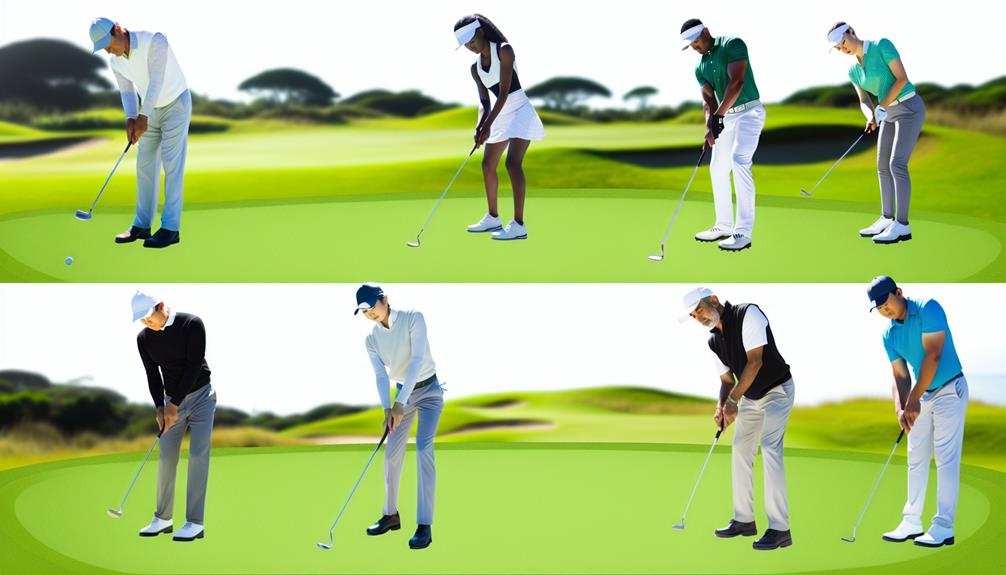Just as you might believe that finding the Holy Grail would be easier than mastering the perfect golf putt, you're not alone. You're invited to consider five verified putting techniques that could, quite possibly, revolutionize your golf tournament experience.
These aren't your run-of-the-mill strategies, but rather techniques that professionals have tested, refined, and vouched for. While we're not promising the Holy Grail, you might just find your personal game-changer amongst them, the secret weapon that will give you an edge on the green.
So why not explore further?
Understanding Golf Tournament Putting
Often, mastering the art of putting can significantly elevate your performance in golf tournaments, as it requires not only technical skill, but also a deep understanding of the greens and a cool head under pressure. You've probably noticed that the best golfers have an uncanny ability to read the greens. It's not magic, but a result of extensive tournament preparation and practice.
To improve your putting, start by learning green reading techniques. These can help you predict how the ball will roll and its likely speed. Spend time studying the green's contours, grain direction, and moisture levels. Remember, a slight slope or bump can dramatically alter the ball's trajectory.
Next, focus on your stroke. You need a smooth, consistent motion, with your eyes on the ball and your body perfectly still. Work on maintaining a steady rhythm, and don't rush. It's the quality of the stroke, not the speed, that counts.
The Pendulum Putting Technique
Harnessing the Pendulum Putting Technique can markedly transform your golfing strategy, as it advocates for a smooth, rhythmic stroke reminiscent of a pendulum's swing. This method, rooted in pendulum physics, focuses on maintaining stroke consistency and optimising control.
Think of your arms and the club as a single unit, forming an inverted pendulum. Your shoulders act as the fulcrum, while your wrists remain locked. It's crucial to keep your wrists firm during the swing as allowing them to break can disrupt the flow and balance, affecting your stroke consistency.
The trick is to maintain a steady tempo, just like a pendulum. The back and forward strokes should be symmetrical, both in distance and time. This technique encourages you to use the big muscles in your shoulders and back, rather than your hands and wrists, offering greater control and precision.
Pendulum putting requires practice but, once mastered, it can be a game-changer. It's a technique that's been embraced by many professional golfers for its simplicity and effectiveness. So, give it a try and see the difference it can make to your putting game.
The Cross-Handed Putting Strategy
While the Pendulum Putting Technique relies on the shoulders and back for precision, another effective strategy you might consider is the Cross-Handed Putting Strategy, which demands a unique hand placement for enhanced control.
In this technique, your left hand (for right-handed golfers) or right hand (for left-handed golfers) is placed below the other on the grip. This unconventional grip positioning can help improve your stroke consistency.
The Cross-Handed Putting Strategy may feel awkward initially, but with practice, you'll find it can bring significant improvement in control and accuracy. This technique helps limit wrist movement, promoting a smoother, more pendulum-like stroke. It's particularly beneficial for golfers who struggle with short putts or those who tend to miss left or right of the hole.
The Claw Grip Putting Method
Shifting gears, let's delve into the Claw Grip Putting Method, a technique that's known to enhance stability and precision, especially under the pressure of a golf tournament. Unlike traditional grip styles, the Claw Grip is unique. It offers a distinctive approach to handling your club, and it might just be the secret ingredient you need to elevate your game.
Grip variations abound in golf, but none quite like the Claw. Here's how it works: your left hand (assuming you're a right-handed golfer) holds the club conventionally, while your right hand adopts a claw-like posture, fingers pointing down. The grip of your right hand is more relaxed, thus providing excellent pressure control.
This grip is designed to keep the right hand from dominating the stroke, which often leads to mis-hits. The Claw Grip promotes a more shoulder-driven stroke, minimizing the wrist action that often causes inconsistencies.
Pressure control is a premium with this method. As the right hand is more relaxed, you're less likely to choke under pressure, ensuring a smoother stroke even in high-stress tournament scenarios.
The Claw Grip Putting Method may be unconventional, but it's a proven strategy to improve your putting precision and stability. It's worth giving a shot in your next practice session.
Mastering the Side-Saddle Putting Technique
Ever wondered how to master the Side-Saddle Putting Technique in golf? The time has come to uncover the mystery. This technique, also known as face-on putting, is a unique but effective method for sinking those crucial putts.
One of the prominent Side Saddle Benefits is that it naturally aligns your eyes directly over the ball and the target line. This alignment simplifies the putting stroke and increases accuracy. It's like shooting a basketball free throw; you face the hoop directly, improving your aim.
Technique Refinement is key to mastering this method. Start by standing to the left of the ball (for right-handers), facing the hole. Hold the club with your right hand at the top of the grip and your left hand lower down, keeping the shaft vertical. Swing the club like a pendulum, using your shoulders, not your wrists.
But remember, practice makes perfect. To truly grasp this technique, it's important to practice regularly. Initially, it may feel odd as it's quite different from traditional styles. However, with dedication and patience, you'll see a significant improvement in your putting accuracy and consistency.

